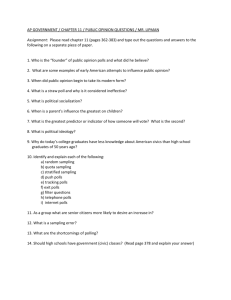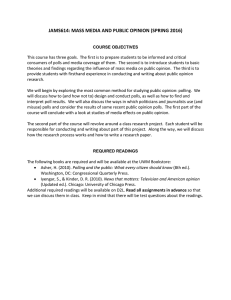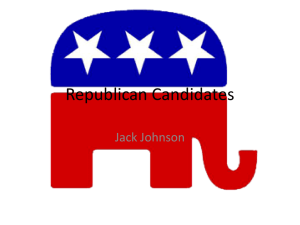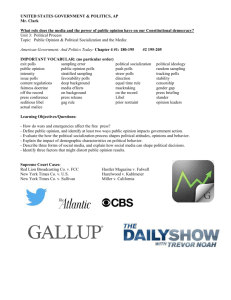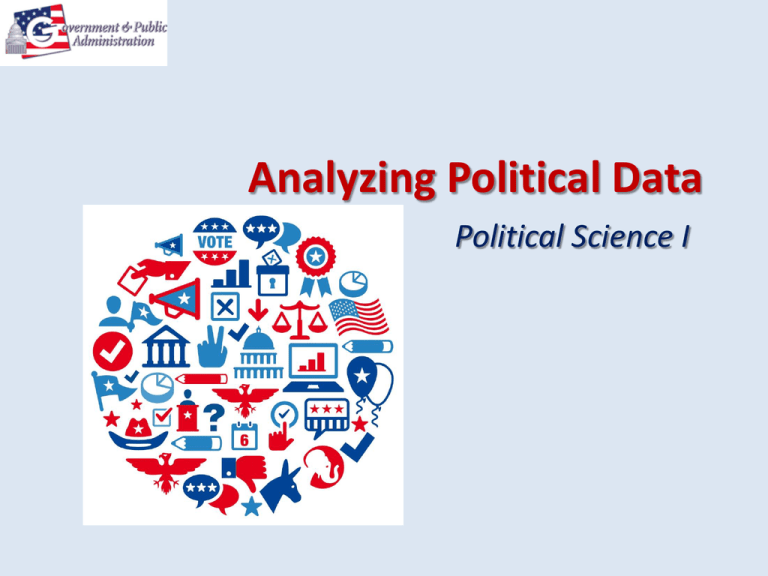
Analyzing Political Data
Political Science I
Copyright and Terms of Service
Copyright © Texas Education Agency, 2014. These materials are copyrighted © and trademarked
™ as the property of the Texas Education Agency (TEA) and may not be reproduced without the
express written permission of TEA, except under the following conditions:
1) Texas public school districts, charter schools, and Education Service Centers may reproduce
and use copies of the Materials and Related Materials for the districts’ and schools’
educational use without obtaining permission from TEA.
2) Residents of the state of Texas may reproduce and use copies of the Materials and Related
Materials for individual personal use only, without obtaining written permission of TEA.
3) Any portion reproduced must be reproduced in its entirety and remain unedited, unaltered
and unchanged in any way.
4) No monetary charge can be made for the reproduced materials or any document containing
them; however, a reasonable charge to cover only the cost of reproduction and distribution
may be charged.
Private entities or persons located in Texas that are not Texas public school districts, Texas
Education Service Centers, or Texas charter schools or any entity, whether public or private,
educational or non-educational, located outside the state of Texas MUST obtain written approval
from TEA and will be required to enter into a license agreement that may involve the payment of
a licensing fee or a royalty.
Contact TEA Copyrights with any questions you may have.
Copyright © Texas Education Agency 2014. All rights reserved.
Images and other multimedia content used with permission.
2
What role does the information
gathered from polling play?
Copyright © Texas Education Agency 2013. All rights reserved.
Images and other multimedia content used with permission.
3
Political Data
• Information from polling plays an integral role in the political events
at the local, state, and national levels
• Polls can assist decision-makers in
• Determining candidates
• Developing effective campaign strategies
• Proposing legislation
• Political candidates, political parties, news organizations, and
private organizations can all conduct polls to gather information
• Public opinion polls were first invented by George Gallup in 1932
• Public opinion polls are much more accurate today compared to
1932 because they are more scientific and survey carefully
selected samples
Copyright © Texas Education Agency 2014. All rights reserved.
Images and other multimedia content used with permission.
4
Process of Conducting Polls
• Those conducting the poll must determine the
population they are targeting for the survey
• Population is the group of people whose opinions
are of interest and about whom information is
desired
• A sample of 1,000-1,500 people can accurately
represent all potential voters
Copyright © Texas Education Agency 2014. All rights reserved.
Images and other multimedia content used with permission.
5
Process of Conducting Polls
(continued)
• The key to conducting accurate polls is
random sampling, which operates on the
principle that everyone should have an equal
probability of being selected as a part of the
sample
• With polls this size, polls are usually 95
percent accurate of being within 3 percent of
what the entire population thinks (Edwards,
Wattenberg, & Lineberry, 2011)
Copyright © Texas Education Agency 2014. All rights reserved.
Images and other multimedia content used with permission.
6
How is public opinion measured?
Copyright © Texas Education Agency 2013. All rights reserved.
Images and other multimedia content used with permission.
7
Polling the Public
• Public opinion consists of the public’s expressed
views about an issue at a specific point in time
• Public opinion and ideology of the public are
linked because ideology is the lens through which
people view political issues
• Political scientist Elizabeth Noelle-Neumann
argued that public opinion itself is a socializing
agent in that it provides an independent context
that affects political behavior (Harrison & Harris,
2011, p. 195)
Copyright © Texas Education Agency 2014. All rights reserved.
Images and other multimedia content used with permission.
8
Polling the Public (continued)
• Public opinion manifests in various ways, but
public opinion polls are important tools used by
policy makers to get an indicator of the public’s
opinion
• A public opinion poll is a survey of a given
population’s opinion on an issue at a particular point in
time
• Random sampling is a method of poll selection
that gives each person in a group the same chance
of being selected
Copyright © Texas Education Agency 2014. All rights reserved.
Images and other multimedia content used with permission.
9
Quota Sampling
• Is a scientifically sophisticated method of sampling
rather than random sampling
• A pollster structures the sample so that it is
representative of the characteristics of the target
population
• This data is usually collected from census data
• For example, if census data states that 40 percent of the
population is white, then 40 percent of the target sample
should be considered white
• Since this might make participants uncomfortable, it is
better to collect demographic information at the end of
the poll
Copyright © Texas Education Agency 2014. All rights reserved.
Images and other multimedia content used with permission.
10
Stratified Sampling
• The national population is divided into fourths
and certain areas within these regions are
selected as representative of the national
population
• Larger organizations and media polls now use
stratified sampling
• Stratified sampling is the most reliable form of
random sampling (Harrison & Harris, 2011, p.
200)
Copyright © Texas Education Agency 2014. All rights reserved.
Images and other multimedia content used with permission.
11
Stratified Sampling (continued)
• Nearly every major polling organization relies
on US census data as the basis of its four
sampling regions
• Stratified sampling is the basis for much of the
public opinion data used by political scientists
and other social scientists
Copyright © Texas Education Agency 2014. All rights reserved.
Images and other multimedia content used with permission.
12
How does public opinion polling
affect politics?
Copyright © Texas Education Agency 2013. All rights reserved.
Images and other multimedia content used with permission.
13
Role of Polls
• Results of polls
• Polls help political candidates detect public
preferences
• Polls help policymakers to keep in touch with
changing opinions on the issues
• If the polls reflect a shift, then the government officials
can make corresponding midcourse corrections
• Polls can also create a bandwagon effect, which means
that the population will support a certain candidate or
legislation merely because a majority of people are
doing so
Copyright © Texas Education Agency 2014. All rights reserved.
Images and other multimedia content used with permission.
14
Role of Polls (continued)
• Public opinion about the government
• Analysts of public opinion and government officials are
concerned with public opinion about the government at all
levels
• Public opinion researchers are often asked to rate their level
of trust in the government in regards to
domestic/international policy and the executive, legislative,
and judicial branches
• The responses to these questions are important for several reasons;
for instance, they measure opinions about the federal institution
rather than the individual
• The levels of trust in the government often rise and fall
over time depending on circumstances like the economy,
war, social issues, etc.
Copyright © Texas Education Agency 2014. All rights reserved.
Images and other multimedia content used with permission.
15
Public Opinion and Policymaking
• Public opinion polling and democracy
• Policy makers are very responsive to public opinion
polls
• Political scientists Shapiro and Page show that when
the public supports a policy change, the following
occurs: policy changes in a direction consistent with
the change in public opinion (Schmidt, Shelley, Bardes
& Ford, p. 237)
• Shapiro and Page also state that when public opinion
changes by 20 percentage points or more, the
government policy is much more likely to follow the
changing public attitudes (Schmidt, Shelley, Bardes, &
Ford, 2012, p. 237)
Copyright © Texas Education Agency 2014. All rights reserved.
Images and other multimedia content used with permission.
16
Public Opinion and Policymaking
(continued)
• Setting limits on government action
• Public opinion polls cannot give exact guidance on
what the government should do in a specific instance
• Given the distribution of certain results, most elected
officials would rather not try to change policy to favor
either of the extreme positions
• Public opinion polls can only give policymakers a
limited amount of guidance when it comes to decision
making
• Policymakers must make their own choices when it
comes to creating legislation
Copyright © Texas Education Agency 2014. All rights reserved.
Images and other multimedia content used with permission.
17
Resources
• Edwards, George, Martin Wattenberg, and Robert Lineberry.
Government in America: People, Politics and Policy. 15. New York
City: Longman, 2011. Chapter 17 & 21. Print.
• Harrison, Brigid, and Jean Harris. American Democracy Now. 2.
New York City: McGrawHill Company, 2011. Chapter 15 & 18.
Print.
• O'Conner, Karen, Larry Sabato, and Alixandra Yanus. American
Government: Roots and Reform. 2011. New York City: Longman,
2011. Chapter 4 & 18. Print.
• Patterson, Thomas. The American Democracy. 9th. New York City:
McGraw Hill Higher Education, 2009. Ch. 15 & 18. Print.
• Schmidt, Steffan, Mack Shelley, Barbara Bardes, and Lynne Ford.
American Government and Politics Today. 2011-2012. Boston:
Wadsworth Cenage Learning, 2012. Chapter 17 &19. Print.
Copyright © Texas Education Agency 2014. All rights reserved.
Images and other multimedia content used with permission.
18

